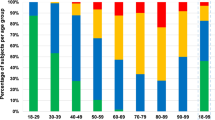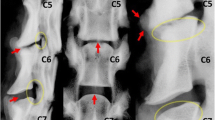Abstract
Trauma and degenerative pathologies at the lower cervical spine are different from lumbar spine pathologies. However, the description of cervical discs is classically taught similarly to that of the lumbar discs. Recent studies have raised this issue, and in 1999, Mercer and Bogduk described ventral annulus fibrosus as a crescent-shaped interosseous ligament. We propose a metric analysis of the different components of the cervical disc to examine this description. We analyzed 140 sagittal and coronal transections of 35 discs. These discs were taken from seven cervical spines at the five lower levels, C2-C3, C3-C4, C4-C5, C5-C6 and C6-C7. We measured quantitative parameters on sagittal, para-sagittal, ventral coronal and dorsal coronal colored transections: disc length (L), ventral annulus thickness (VAF), lateral annulus thickness (LAF), dorsal annulus thickness (DAF), length of the fibrocartilaginous tissue (FC), sagittal and coronal fibrocartilaginous core ratio (% Core) and intra-disc cleft length (Cleft). We also measured two qualitative parameters: degenerative disease of cartilaginous end plates and total intra-disc cleft. Finally, we examined 114 transections, and 18.5% were ruled out. The results showed thick ventral annulus fibrosus, thin lateral annulus and a very thin dorsal annulus. Fibrocartilaginous tissue filled the dorsal sagittal half of the disc. Intra-disc cleft split the fibrocartilaginous tissue and spread through the ventral annulus only six times. The shape of the ventral annulus at the lower cervical spine is compared to a pivot-hinge device. The aspect is functionally discussed in regard to teardrop fractures, unilateral locked facet syndrome and degenerative changes in the unco-vertebral area.





Similar content being viewed by others
References
Argenson C, De Peretti F, Ghabris A (1994) Classification et indications thérapeutiques pour les fractures du rachis cervical inférieur (C3-C7). In: Kehr P (ed) Rachis cervical dégénératif et traumatique. Cahiers d’enseignement de la SoFCOT no. 48, Duparc Ed. Expansion scientifique française, Paris, pp 100–112
Chirossel J-P, Vanneuville J, Passagia J-G, Chazal J, Coillard Ch, Favre J-J, Garcier J-M, Tonetti J, Guillot M (1995) Biomechanics and classification of traumatic lesions of the spine. Adv Tech Stand Neurosurg 22:55–135
Crawford NR, Duggal N, Chamberlain RH, Park SC, Sonntag VK, Dickman CA (2002) Unilateral cervical facet dislocation: injury mechanism and biomechanical consequences. Spine 17:1858–1864
Grignon B, Roland J (2000). Can the human intervertebral disc be compared to a diarthrodial joint? Surg Radiol Anat 22:101–105
Hayashi K, Yabuki T, Kurosawa T, Seki H, Hogari M, Minoura S (1977) The anterior and the posterior longitudinal ligaments of the lower cervical spine. J Anat 124:633–636
Kumaresan S, Yoganandan N, Pintar FA, Macias M, Cusick JF (2000) Morphology of young and old cervical spine intervertebral disc tissues. Biomed Sci Instrum 36:141–146
Lysell E (1969) Motion of the cervical spine. An experimental study on autopsy specimen. Acta Orthop Scand 123 [Suppl]:1–61
Maigne JY, Mutschler C, Doursounian L (2003) Acute torticoli in an adolescent: case report and MRI study. Spine 1:E13–15
Mercer S, Bogduk N (1999) The ligaments and annulus fibrosus of human adult cervical intervertebral discs. Spine 24:619–628
Milne N (1991) The role of zygapophyseal joint orientation and uncinate processes in controlling motion in the cervical spine. J Anat 178:189–201
Panjabi MM, White III AA, Johnson RM (1975) Cervical spine mechanics as function of transection of components. J Biomech 4:327–336
Panjabi MM, Cholewicki J, Nibu K, Grauer J, Vahldiek M (1998) Capsular ligament stretches during in vitro whiplash simulations. J Spinal Disord 11:227–232
Penning L (1988) Differences in anatomy, motion, development, and ageing of the upper and lower cervical disc segments. Clin Biomech 3:37–47
Pooni JS, Hukins DWL, Harris PF, Hilton RC, Davies KE (1986) Comparison of the structure of human intervertebral discs in the cervical, thoracic and lumbar regions of the spine. Surg Radiol Anat 8:175–182
Rabischong P, Louis R, Vignaud J, Massare C (1978) Le disque intervertébral. Anatom Clin 1:55–64
Rauschning W, McAfee P C, Jonssn H Jr (1989) Pathoanatomical and surgical findings in cervical spinal injuries. J Spinal Disord 4:213–222
Scott JE, Bosworth TR, Cribb AM, Taylor JR (1994) The chemical morphology of age-related changes in human intervertebral disc glycosaminoglycans from cervical, thoracic and lumbar nucleus pulposus and annulus fibrosus. J Anat 1:73–82
Taylor JR, Twomey LT (1993) Acute injury to cervical joints. An autopsy study of neck sprain. Spine 18:1115–1122
Töndury G (1972) Anatomie fonctionnelle des petites articulations du rachis. Annales de médecine physique 15:173–191
Tonetti J, Peoc’h M, Merloz Ph, Pasquier B, Chirossel JP (1999) Elastic reinforcement and thickness of articular capsule at the lower cervical spine. Surg Radiol Anat 21:35–39
Trout JJ, Buckwalker JA, Moore KC (1982) Ultrastructure of the human intervertebral disc. Anat Rec 204:307–314
Vital JM, Gille O, Senegas J, Pointillart V (1998) Reduction technique for uni- and biarticular dislocations of the lower cervical spine. Spine 8:949–954
Zaki W (1973) Aspects morphologiques et fonctionnels de l’annulus fibrosus du disque intervertébral de la colonne cervicale. Bull Ass Anat 158:649–654
Zdeblick A, Abitbol JJ, Kunz DN, Mc Cabe RP, Garfin S (1993) Cervical stability after sequential capsule resection. Spine 14:2005–2008
Author information
Authors and Affiliations
Corresponding author
Rights and permissions
About this article
Cite this article
Tonetti, J., Potton, L., Riboud, R. et al. Morphological cervical disc analysis applied to traumatic and degenerative lesions. Surg Radiol Anat 27, 192–200 (2005). https://doi.org/10.1007/s00276-004-0309-0
Received:
Accepted:
Published:
Issue Date:
DOI: https://doi.org/10.1007/s00276-004-0309-0




